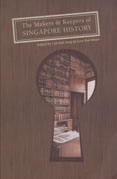
This multi-authored volume comprises 23 chapters that narrate, analyse and reflect on the production of history in Singapore in recent years. Its origins lie in the frustrations of its two editors, Loh Kah Seng and Liew Kai Khium, in gaining access to the archival records they needed for work they were doing on some little known aspects of Singapore's past. This led to a symposium in 2008. The current book, The Makers & Keepers of Singapore History, is the result of that symposium.
At the symposium there emerged the idea of the three themes — the 'gates' — around which the book is framed. There are the 'front gates' (official archives in Singapore), 'side gates' (foreign archives), and 'memory gates' (oral history). In his opening chapter, co-editor Loh Kah Seng observes that 'gatekeeping strongly influences the process of researching present-ing [sic] the past', and this is particularly so in Singapore. This is due to the influence of Lee Kuan Yew, first Prime Minister of Singapore and, as Loh observes, 'the most important maker and keeper of Singapore's recent past'. There is the so-called 'Singapore story' through which many of this book's contributors have lived: the officially sanctioned linear narrative of post-war progress 'from Third World to First'. As Loh remarks, it is about 'always looking ahead, looking for bigger and better things'. Even when a history of Lee Kuan Yew's People's Action Party was published in 2009, under the title Men in White, it was Lee and Prime Minister Goh Chok Tong who made possible the authors' access to access to government records and who enabled the stories of Lee's political opponents to be told. Hence the constant probing in this book on who controls the past — on who are the 'makers', 'gatekeepers' and 'safekeepers' of the nation's past — and how fluid and interchangeable those roles can be.
The scope of the book is broad. There is an absorption in the early chapters with archives, those traditional sources for the writing of history. But also included in the consideration of 'front gates' are the National Museum of Singapore, and the official custody of archaeological material from which a more complex history of Singapore could be written, if that material was more accessible. Kevin YL Tan describes the long complex history of the National Museum of Singapore, and remarks that the current iteration of the museum, which emerged in 2006 after three years of renovations, devotes comparatively little space to the history of Singapore. Moreover, various parts of what had once been nationally significant collections relating to natural history, ethnography, art and science were hived off into other museums. Damningly, Tan concludes that the National Museum of Singapore is more a 'lifestyle space' and 'interpretative centre' than a repository of historical artefacts and that it fails in its roles as both keeper and maker of Singapore history.
The section of the book covering the 'side gates' to Singapore's history — researching via foreign archives in cases where local official records are inaccessible — includes a number of chapters on the process of research and the personal journey of the researchers who have travelled abroad in order to recover aspects of Singapore's past. Syed Muhd Khairudin Aljunied found it necessary, when researching the history of racial and religious riots in 1950, to travel beyond Singapore's national shores to unearth 'truths' that would liberate Singaporeans from 'national ethnic and political myths' that had shaped their lives. Other historians sound a cautionary note, that material in foreign archives is inevitably created from a Western perspective. In an earlier section of the book, Kwa Chong Guan and Ho Chi Tim warn that even if historians get through the so-called 'front gates', the official archives in Singapore (including the National Archives of Singapore), the problem of perspective is still present. Historians — all historians, not just historians of Singapore — need to understand the complex processes by which records are created in the first place. What is in the archives, and why? What records are not created, or collected? The challenge for historians, these authors believe, is not so much getting past the 'gatekeepers', as maintaining awareness of the different and divergent social memories embedded in the records they are seeking.
Oral history and film-making dominate the last section of the book, 'Memory gates'. Ernest Koh Wee Song describes fieldwork he undertook between 2005 and 2008 among Singaporeans whose stories were, not surprisingly, different from the official narratives of Singapore's past. For film-maker Eng Yee Peng, finding those voices was her explicit intention in making her film, Diminishing Memories (2005) about her family's forced relocation in 1986 from a village in Lim Chu Kang, to make way for redevelopment. The voices of the people in her community are lacking in official records, she says, so she focused on recovering those voices and decided to exclude the voice of authorities. She realised, she said, that the authorities 'have many channels to say what they want to say. We are the ones that haven't got the platform to do that.'
Eng Yee Peng's contribution to this book is in the form of an interview with Loh Kah Seng. It is a form that suits the subject and an example of the diversity of perspective that the book encompasses. The book should find a broad readership not just among people interested in Singaporean history, but all who are interested in how history is researched, produced and consumed.
